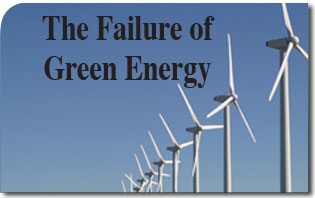 Who would not want renewable, clean and affordable energy? The promise is great, but do green power sources live up to their claims? It seems that the only green to be found is from taxpayers’ pockets to environmentally friendly construction companies. Green energy is big business delivering small returns.
Who would not want renewable, clean and affordable energy? The promise is great, but do green power sources live up to their claims? It seems that the only green to be found is from taxpayers’ pockets to environmentally friendly construction companies. Green energy is big business delivering small returns.
It seems there are a few inconvenient truths to be uncovered when looking at the benefits of clean wind and sun energy. Perhaps a few trivial items should be mentioned, such as cost of installation, additional transmission lines, backup power plants to deal with uncertain weather conditions, short life span of wind turbines and massive taxpayer subsidies.
Such details are not found in some statements from the Office of Energy Efficiency and Renewable Energy (EERE). This office claims “wind energy is one of the lowest-priced renewable energy technologies available today, costing between 4 and 6 cents per kilowatt-hour…”1 It is no wonder that many people think clean green energy is a viable solution, notwithstanding the fact that it destroys beautiful landscapes and kills the iconic American Golden and Bald Eagles.
In an unprecedented effort by the federal government to supply alternative green energy, U.S. taxpayers had handed over no less than $100 billion since 2006.2 When government bureaucrats, with no skin in the game, attempt to manage the private sector, costly failures ensue.
The Institute for Energy Research released the flowing list of power plants types with corresponding federal subsidies:
Natural gas and coal—$0.64 per megawatt hour of production,
Hydroelectric power—$0.82,
Nuclear—$3.14,
Geothermal—$12.85,
Wind turbines—$56.29
Solar energy—$775.64.3
It is sorely evident that without continual taxpayer subsidies, geothermal, wind and solar energy generation are nothing more than a green farce burdening the U.S. taxpayer in the pursuit of utopia.
Green power has been touted to be the future of energy, that is, until it proved to be unsustainable. The American Wind Energy Association (AWEA) saw the wind industry growth plummet 92 percent in 2013, in large part due to the uncertainty of whether the federal wind Production Tax Credit (PTC) would be extended in the future. Although the AWEA has been receiving huge tax credits for a decade all the while promising an elusive profitability at the end of the rainbow, profits are not projected in the foreseeable future. In other words, without enormous taxpayer subsidies, green energy will not deliver a ROI for investors.
The federal government has changed the language in the PTC that expired in January 2014 stating that a wind farm need not be “in production” to receive credits. It is enough that the turbines be “under construction,” to qualify. The new language in the PTC creates a race to start a project, not finish one.
In an eye-opening study titled, “The Hidden Costs of Wind Electricity” written by George Taylor and Thomas Tanton, the real price of wind turbine generation is objectively examined and reveals the true costs to be triple that of natural gas and substantially higher than coal and nuclear.4 So why is the federal government pushing green energy at such a high cost to the taxpayer?
Taylor and Tanton have calculated that Americans are paying at least $8.5 billion more for wind power versus natural gas generation not including billions in tax dollars in federal subsidies. These tax credits to the wind industry are but another cost passed on to all taxpayers, not just users of wind power. If consumers wish to pay dearly for green energy they may do so at their own expense, but they are not entitled to force others to carry the financial burden. The wind industry is asking congress for another $50 billion over the next six years to phase out these subsidies. This is a total of $150 billion tax dollars to support a failed industry.
Currently high maintenance costs, massive failure rates and unpredictable weather conditions have rendered wind turbines and solar expensive and inefficient. This accounts in part for why more than 14,000 wind turbines lie idle in California’s Altamont Pass, Tehachapin and San Gorgonio areas, considered the best wind spots on earth.5
Even though wind power is cheaper than it was a decade ago, it has little to show for having received such a great degree of preferential treatment. For that matter, if liberals really believed in equality, they would give the same subsidies to all energy producing facilities, or take them all away in the name of “fairness.” However, do not expect to see things change any time soon, as equality only applies when it favors the left’s agenda. Until someone with common sense puts the brakes on this insane green roller coaster ride, we can expect to pay increasingly higher rates as we stifle the tried and proven methods of traditional power sources and fund the failure of green energy.
Footnotes
- http://energy.gov/eere/wind/advantages-and-challenges-wind-energy
- http://www.masterresource.org/2014/04/republicans-for-obama-ptc/
- http://www.instituteforenergyresearch.org/2011/08/03/eia-releases-new-subsidy-report-subsidies-for-renewables-increase-186-percent/
- http://www.atinstitute.org/wp-content/uploads/2012/12/Hidden-Cost.pdf
- http://www.thenewamerican.com/tech/energy/item/15069-14-000-idle-wind-turbines-a-testament-to-failed-energy-policies

